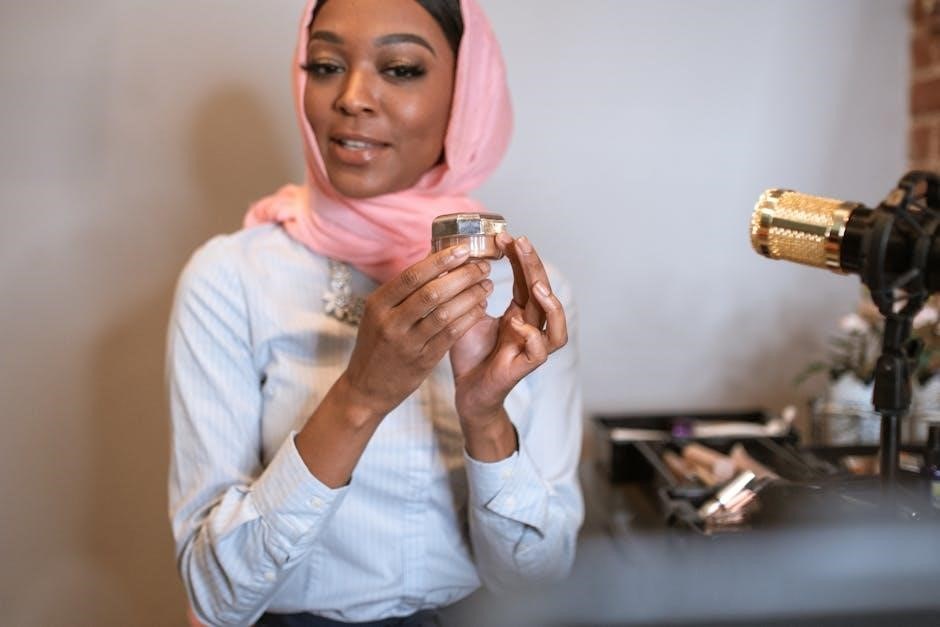Sexual education is a comprehensive guide to understanding human sexuality, focusing on safety, consent, and health. Tutorials provide accessible, clear information for all ages, fostering healthy attitudes and informed decision-making through engaging content.
1.1. Definition and Importance
Sexual education refers to the process of acquiring knowledge and skills about human sexuality, relationships, and sexual health. It is essential for promoting healthy behaviors, preventing sexually transmitted infections, and fostering respect for diversity. By addressing physical, emotional, and social aspects, sexual education empowers individuals to make informed decisions. Its importance lies in reducing stigma, encouraging consent, and preparing individuals for healthy relationships. Effective sexual education is critical for personal well-being, societal health, and the development of future generations, making it a cornerstone of comprehensive health education worldwide.
1.2. Historical Context
Sexual education has evolved significantly over centuries, shaped by cultural norms, scientific advancements, and societal values. Early efforts focused on abstinence and moral guidance, while modern approaches emphasize comprehensive understanding. The 20th century saw milestones like sex education in schools, beginning in the 1960s, and the rise of HIV/AIDS awareness in the 1980s, which highlighted its importance. Today, sexual education integrates diverse perspectives, recognizing the need for inclusive and evidence-based content to address contemporary challenges and promote sexual health globally, reflecting a journey from taboo to essential life skill.
1.3. Global Perspectives
Sexual education varies widely across cultures, reflecting diverse societal values and norms. In some regions, comprehensive programs are integrated into school curricula, while others focus on abstinence or traditional practices. Cultural and religious influences often shape the content and delivery of sexual education, with varying degrees of emphasis on topics like consent, contraception, and LGBTQ+ rights. Despite differences, there is growing recognition of the importance of age-appropriate, evidence-based education to promote sexual health and well-being globally, with many countries adopting innovative approaches to address their unique challenges and cultural contexts effectively.

The Role of Tutorials in Sexual Education
Tutorials serve as essential tools for sexual education, offering accessible, engaging content. They provide clear, accurate information, fostering informed decisions and healthy attitudes toward sexuality and relationships.
2.1. Types of Tutorials
Sexual education tutorials vary in format, catering to diverse learning preferences. Interactive modules, videos, and quizzes engage users, while written guides provide in-depth information. Virtual reality tutorials offer immersive experiences, enhancing understanding of complex topics. Mobile apps deliver convenience, allowing learners to access content anytime. These varied approaches ensure comprehensive learning, making sexual education accessible and effective for all individuals, regardless of their learning style or technological preference.
2.2. Benefits of Interactive Learning
Interactive learning enhances engagement and retention in sexual education by providing hands-on experiences. Quizzes, simulations, and discussions encourage active participation, making complex topics more relatable. Personalized pacing allows learners to explore content at their own speed, improving understanding. Immediate feedback helps clarify misconceptions, while collaborative tools foster a supportive environment for sharing experiences. Interactive platforms also cater to different learning styles, ensuring that visual, auditory, and kinesthetic learners can all benefit equally. This approach not only educates but also empowers individuals to make informed decisions about their sexual health.
2.3. Effectiveness in Knowledge Retention
Interactive tutorials significantly improve knowledge retention in sexual education by engaging learners through practical exercises and real-world scenarios. The ability to revisit content and receive immediate feedback enhances understanding and reduces misinformation. Studies show that hands-on learning increases long-term retention compared to passive methods. Interactive tools also help learners connect theoretical concepts to personal experiences, making the information more relevant and memorable. This approach ensures that critical lessons about sexual health and safety are retained and applied effectively in real-life situations.

Key Topics Covered in Sexual Education Tutorials
Sexual education tutorials cover essential topics like anatomy, sexual health, consent, and safe practices, ensuring a well-rounded understanding of human sexuality and its implications for overall well-being.
3.1. Anatomy and Physiology
Understanding anatomy and physiology is fundamental in sexual education. Tutorials provide detailed explanations of male and female reproductive systems, including functions of organs like the uterus, ovaries, penis, and testicles. Topics also cover hormonal processes, such as puberty and menstruation, explaining how these changes affect the body. This knowledge helps individuals grasp how their bodies work, promoting awareness of sexual health and hygiene practices. Interactive visuals and diagrams often accompany these lessons to enhance comprehension and engagement for learners of all ages.
3.2. Sexual Health and Hygiene
Sexual health and hygiene are crucial for overall well-being. Tutorials emphasize the importance of maintaining personal cleanliness, including daily habits and proper care of genital areas. They also cover methods to prevent infections, such as urinary tract infections and sexually transmitted infections (STIs). Topics include the use of protection, regular health check-ups, and understanding symptoms of common conditions. These lessons aim to empower individuals with practical knowledge to maintain their health and make informed decisions about their bodies, fostering confidence and responsibility in sexual wellness.
3.3. Consent and Communication
Consent and communication are cornerstone topics in sexual education, ensuring mutual understanding and respect in all interactions. Tutorials highlight the importance of clear, voluntary agreement before any sexual activity, emphasizing that consent must be freely given, reversible, and informed. Effective communication involves active listening, expressing boundaries, and respecting partners’ decisions. These skills foster trust, healthy relationships, and emotional well-being. By prioritizing open dialogue, individuals can navigate situations confidently, ensuring that all parties feel safe and valued. This foundation is essential for building positive, respectful connections throughout life.
3.4. Safe Sex Practices
Safe sex practices are essential for preventing sexually transmitted infections (STIs) and unintended pregnancies. These practices include using condoms, dental dams, and other barrier methods correctly and consistently. Birth control methods, such as pills, IUDs, or implants, can also be effective when used as directed. Open communication with partners about sexual history and preferences is crucial. Regular STI testing and mutual agreement on protection are key components of responsible sexual behavior. Education on these practices empowers individuals to make informed decisions, fostering healthier and more respectful relationships.

Psychological Aspects of Sexual Education
Sexual education addresses emotional development, mental health, and self-esteem, fostering a positive understanding of sexuality and relationships. It encourages self-awareness and emotional intelligence for healthy interactions.
4.1. Emotional Maturity
Emotional maturity is a critical component of sexual education, enabling individuals to understand their feelings, values, and boundaries. It fosters respect for oneself and others, promoting healthy relationships. This aspect helps individuals navigate intimacy with confidence and empathy, making informed decisions about their sexual well-being. Emotional maturity also encourages open communication and the ability to handle emotions responsibly, which are essential for maintaining trust and respect in partnerships. By addressing emotional development, sexual education empowers individuals to approach sexuality with self-awareness and emotional intelligence, contributing to overall mental health and positive relationship dynamics.
4.2. Mental Health
Mental health plays a vital role in sexual education, as it addresses the emotional and psychological aspects of sexuality. Understanding personal boundaries, managing stress, and fostering self-esteem are key components. Sexual education helps individuals develop a positive body image and navigate societal pressures. It also equips them with skills to cope with anxiety or shame related to sexuality. By promoting mental well-being, sexual education encourages healthy relationships and overall emotional resilience, empowering individuals to make informed, confident decisions about their sexual health and well-being.
4.3. Building Healthy Relationships
Building healthy relationships is essential for emotional and sexual well-being. It involves fostering trust, respect, and open communication between partners. Understanding boundaries and mutual consent are crucial for a balanced relationship. Education plays a key role in teaching individuals how to navigate relationship dynamics, ensuring both partners feel valued and heard. By emphasizing empathy and understanding, sexual education helps create a foundation for lasting, healthy connections.

Communication Strategies
Effective communication is vital for understanding and expressing sexual needs and boundaries. Open dialogue and active listening foster trust, ensuring mutual respect and clarity in relationships.
5.1. Open Dialogue
Open dialogue fosters honesty and understanding, encouraging individuals to express their thoughts and feelings about sexuality. It creates a safe space for questions and discussions, reducing stigma and misconceptions. By promoting active participation, open dialogue helps individuals navigate complex topics with confidence and clarity, ensuring healthy relationships and informed decisions.
5.2. Active Listening
Active listening is a vital communication strategy that involves fully engaging with the speaker, understanding their perspective, and responding thoughtfully. In sexual education, it ensures that concerns and questions are addressed with empathy and clarity. By maintaining eye contact, nodding, and asking clarifying questions, active listening helps build trust and fosters open communication. This approach encourages individuals to express themselves freely, creating a supportive environment for learning and growth. It also helps in resolving misunderstandings and ensuring that information is accurately understood and applied.
5.3. Conflict Resolution
Conflict resolution is a crucial skill in sexual education, helping individuals navigate disagreements and misunderstandings respectfully. It involves identifying issues, remaining calm, and seeking mutually beneficial solutions. Effective conflict resolution fosters healthy relationships by promoting understanding and respect. Open communication and empathy are key, allowing individuals to address concerns without escalating tensions. By teaching conflict resolution, sexual education empowers individuals to handle challenges constructively, ensuring stronger, more respectful connections. This skill is essential for building and maintaining trust in all relationships, whether romantic, familial, or platonic.

The Impact of Technology on Sexual Education
Technology revolutionizes sexual education through interactive tutorials, apps, and virtual reality, modernizing traditional methods and providing enhanced accessibility and engagement for learners worldwide.
6.1. Online Resources
Online resources have transformed sexual education by offering accessible, accurate, and engaging content. Websites, webinars, and forums provide comprehensive information on various topics, including anatomy, consent, and health.
These platforms cater to diverse audiences, ensuring inclusivity and privacy. Interactive tools like quizzes and videos enhance learning experiences, making complex topics more relatable.
Trusted organizations like Planned Parenthood and Amaze.org lead in offering reliable materials. Online resources empower individuals to make informed decisions, fostering a culture of sexual well-being and awareness.
6.2. Apps and Digital Tools
Apps and digital tools are revolutionizing sexual education by making it interactive and accessible. Applications like Clue and Glow offer insights into reproductive health, while others provide tutorials on consent and safe practices.
These tools often include features like privacy settings, AI-driven Q&A, and gamified learning to engage users. They cater to diverse needs, ensuring accurate information is available anytime, anywhere.
Such innovations bridge gaps in traditional education, empowering users with knowledge and confidence to navigate their sexual well-being effectively.
6.3. Virtual Reality Applications
Virtual Reality (VR) applications are transforming sexual education by offering immersive, interactive experiences. These tools simulate real-life scenarios, enabling users to explore topics like consent, anatomy, and safe practices in a controlled environment.
VR tutorials provide engaging, three-dimensional lessons that enhance understanding and retention; They also allow users to practice communication skills and decision-making without real-world consequences.
Such applications are particularly effective for addressing sensitive subjects, offering a private and non-judgmental space for learning.

Cultural and Religious Considerations
Cultural and religious beliefs significantly influence attitudes toward sexual education. Diverse traditions shape values, leading to varied approaches in teaching and discussing sexuality, emphasizing respect for individual beliefs.
7.1. Cultural Differences
Cultural differences play a pivotal role in shaping sexual education. In some societies, open discussions about sexuality are encouraged, while others emphasize modesty and privacy. Traditional practices, such as arranged marriages or gender roles, influence how sexual health is taught. For instance, Western cultures often focus on individual consent and autonomy, whereas collectivist societies may prioritize family and community values. These variations highlight the need for culturally sensitive approaches to sexual education, ensuring that materials respect and reflect local norms and traditions. This diversity necessitates adaptable and inclusive educational strategies worldwide.
7.2. Religious Influences
Religious beliefs profoundly shape sexual education, often influencing attitudes toward sexuality, marriage, and reproductive health. Many religions emphasize abstinence before marriage and may restrict discussions on contraception or same-sex relationships. For example, Catholic doctrine opposes artificial birth control, while some Islamic teachings stress modesty and gender segregation. These religious tenets can either complement or conflict with secular sexual health education. Understanding these dynamics is crucial for creating programs that respect diverse faith traditions while promoting accurate and inclusive information. Balancing religious values with evidence-based education remains a significant challenge in many communities globally.
7.3. Navigating Diverse Beliefs
Navigating diverse beliefs in sexual education requires cultural sensitivity and open dialogue. Different cultures and religions have varying views on sexuality, influencing how topics like gender roles, consent, and sexual health are addressed. Educators must balance respecting these beliefs with providing accurate, inclusive information. Strategies include fostering open dialogue, incorporating diverse perspectives, and emphasizing shared values like respect and safety. By acknowledging and addressing these differences, sexual education can become more accessible and meaningful for individuals from all backgrounds, promoting understanding and healthy practices.

Legal and Ethical Aspects
Sexual education must adhere to legal standards, including age of consent and privacy rights. Ethical considerations ensure inclusivity, non-discrimination, and accurate information to promote safe, informed practices.
8.1. Age of Consent
The age of consent is the legal minimum age at which individuals are considered capable of consenting to sexual activities. This age varies globally, ranging from 14 to 18 years old, depending on cultural, legal, and ethical norms. It is established to protect minors from exploitation and ensure they can make informed decisions. Sexual education often addresses this topic to highlight its importance in respecting personal boundaries and adhering to legal standards. Understanding the age of consent is crucial for promoting safe and lawful sexual practices within societies worldwide.

8.2. Privacy Rights
Privacy rights are essential in sexual education, ensuring individuals’ personal information and decisions remain confidential. Respecting privacy fosters trust, particularly for vulnerable populations like minors or VEPs (victims of exploitation or abuse). Legal frameworks, such as data protection laws, safeguard sensitive information. Privacy enables honest discussions about sexual health without fear of judgment or discrimination. Ensuring confidentiality is crucial for creating a safe environment where individuals feel comfortable seeking guidance and resources for their well-being.
8.3. Ethical Teaching Practices
Ethical teaching practices in sexual education emphasize impartiality, inclusivity, and respect for diverse beliefs. Educators must avoid bias, ensuring all perspectives are acknowledged while providing accurate, evidence-based information. Confidentiality and student consent are paramount when discussing personal topics. Respect for cultural and religious values is crucial, fostering a safe environment for open dialogue. Ethical practices also involve promoting consent, bodily autonomy, and healthy relationships, equipping learners with the knowledge to make informed decisions responsibly. This approach ensures education is both compassionate and empowering, aligning with legal and moral standards.
Sexual education is essential for fostering healthy attitudes and informed decision-making. It empowers individuals to navigate relationships and personal growth confidently, promoting lifelong learning and well-being.
9.1. Summary of Key Points
Sexual education is vital for understanding human sexuality, emphasizing safety, consent, and health. It covers anatomy, relationships, and hygiene, while addressing mental and emotional well-being. Tutorials provide interactive learning, enhancing knowledge retention and promoting healthy behaviors. Cultural and religious perspectives are considered, ensuring inclusive education. Technology, like apps and online resources, modernizes access to information. Legal aspects, such as privacy and consent, are highlighted to ensure ethical practices. Ultimately, sexual education empowers individuals to make informed decisions, fostering lifelong learning and personal growth in a diverse, global context.
9.2. Future Directions
Future advancements in sexual education may focus on integrating technology, such as virtual reality and AI-driven platforms, to create immersive learning experiences. Expanding accessibility to multilingual resources will ensure inclusivity for diverse populations. Emphasizing stigma reduction and normalization of sexual health discussions will foster healthier societal attitudes. Continuous updates to educational content, reflecting evolving cultural and scientific understanding, will be essential. Collaborative efforts between educators, policymakers, and tech innovators will drive progress, ensuring sexual education remains relevant and impactful in addressing global challenges and promoting lifelong learning.
9.3. Encouraging Lifelong Learning
Encouraging lifelong learning in sexual education is crucial for personal growth and societal progress. It fosters adaptability to evolving information, cultural shifts, and individual experiences. By promoting curiosity and open-mindedness, individuals can continually update their knowledge and skills, ensuring healthy, informed decisions. Accessible, age-appropriate resources and supportive environments play key roles in nurturing this mindset. Lifelong learning empowers individuals to navigate changing norms and technologies confidently, contributing to a more informed and empathetic global community.

Additional Resources
Additional resources for sexual education include recommended websites, books, and support organizations, providing accessible information and tools for continued learning and guidance on sexual health topics.
10.1. Recommended Websites
Recommended websites for sexual education include:
– Planned Parenthood: Offers comprehensive guides on sexual health and tutorials.
– Amaze.org: Provides engaging videos and resources for sexual education.
– Scarleteen: Tailored for teens, offering detailed tutorials and advice.
– The Trevor Project: Focuses on LGBTQ+ youth with supportive resources.
– CDC: Reliable information on sexual health and safety practices.
10.2. Books and Articles
Essential books and articles on sexual education include:
– “It’s Perfectly Normal” by Robie H. Harris: A guide for teens on puberty and sexuality.
– “Sexuality Now” by Janell Carroll: Explores diverse perspectives on sexual health.
– “The Sex-Positive Movement” by Dr. Ruth Westheimer: Promotes open conversations about sexuality.
– Articles from The New York Times and HuffPost often cover modern sexual education topics.
– Academic journals like JSTOR provide in-depth research on sexual health and education.
10.3. Support Organizations
Several organizations offer support and resources for sexual education:
– Planned Parenthood: Provides comprehensive sexual health services and education.
– Amnesty International: Advocates for sexual and reproductive rights globally.
– UNICEF: Focuses on adolescent sexual health and rights worldwide.
– The Trevor Project: Supports LGBTQ+ youth with sexual health resources.
– Sexuality Information and Education Council of the United States (SIECUS): Offers evidence-based sexual education materials.
These organizations ensure access to accurate and inclusive information.
